It’s an irony of history that Buick – once upon a time known for its Barcalounger big cars – now sells one of the smallest ones you can buy.
With one of the smallest engines on four wheels.
Just three cylinders – and 1.2 liters.
Many motorcycles have bigger engines.
But they haven’t got 50.2 cubic feet of cargo capacity – enough to take a motorcycle (if you take it apart) and the little Buick’s back seat, as it turns out, has almost exactly as much legroom as you’d find inside one of the biggest Buick’s ever, the 1970 Riviera.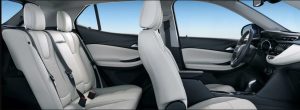
Which was almost four feet longer overall than this Buick.
So, the size is still there. Just not outside.
Or under the hood.
What It Is
The Encore GX is a small crossover SUV, in the same class as models like the Mazda CX3 and Honda HR-V.
It differs from others in the class in being the only vehicle in the class with such a small engine.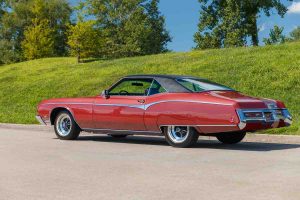
Two of them, actually.
You can upgrade from the standard 1.2 liter engine to a marginally larger 1.3 liter engine – but both of them still much smaller than the engines in rivals like the CX30 and HR-V.
But, what they lack in size they try to make up for in pressure. Both engines are turbocharged. But are they powerful enough – and efficient enough – to make up for their lack of displacement?
Prices start at $24,200 for the base Preferred trim with the 1.2 liter engine and front-wheel-drive. If you buy the available all-wheel-drive system, you get upgraded to the 1.3 liter engine, which is also optional by itself with the mid-trim Select ($25,800) and the top of the line Essence ($28,600) trim.
What’s New
The Encore itself is largely the same as last year but all trims come standard with satellite radio and both Android Auto and AppleCarPlay connectivity this year.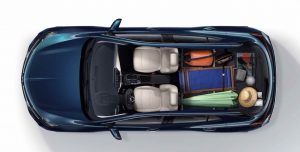
What’s Good
Lots of room – without the size.
Standard turbocharged engine.
Available heated steering wheel, Heads-Up Display and wireless sail fawn charger opener.
What’s Not So Good
Overpriced vs. rivals like the Mazda CX30 – which comes standard with a much stronger engine that doesn’t need a turbo.
Small engine uses about as much gas as larger engines in rivals – without the potential down-the-road cost of a replacement turbo.
Desirable features like the heated steering wheel, HUD and wireless sail fawn charger are extra-cost and only available with the top-of-the-line Essence trim.
Both of the Buick’s engines are so small they need a boost – literally. Turbocharging breathes four cylinder power (137 hp) into the standard 1.2 liter engine and 155 hp into the optional 1.3 liter engine.
Well, almost. Rivals like the CX30 come standard with fours that make more power – 2.5 liters and 186 hp. There’s also the slightly smaller overall Mazda CX3 (no 0). It comes standard with 2.0 liters and 148 hp.
Also a base price of $20,640 – which amounts to a difference of $3,560 vs. the base Encore (and its 137 hp).
The other major rival in this class is the Honda HR-V, which comes standard with 1.8 liters and 141 hp. It lists for $20,820 to start.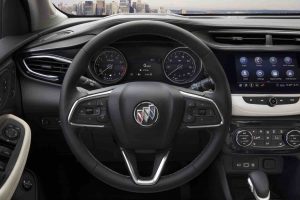
The transmission you get depends on which drive configuration you select. Encores equipped with the 1.2 liter engine automatically get a continuously variable (CVT) automatic and are front-wheel-drive only. The 1.3 liter engine is available with a nine-speed automatic, if you select all-wheel-drive – which is optional. If you stick with FWD, this engine gets paired with the CVT automatic.
Surprising, gas mileage with either engine is pretty mediocre given their smallness. The 1.2 liter engine in FWD configuration returns 28 city, 31 highway. With the slightly larger 1.3 liter engine and AWD, the number drops to 26 city, 29 highway.
For a reference point, the Mazda CX30’s much larger – and much stronger – 2.5 liter four cylinder posts 25 city, 33 highway for the FWD version and 25/32 with AWD.
The 2.0 liter engine in the Mazda CX3 pulls down 29/34 for the FWD version and 27 city/32 highway with the optional AWD.
A Honda HR-V comes standard with a 28 city, 34 highway rating.
So what is the upside, if any, of all this boost?
The main benefit of the Buick’s tiny turbo’d engines isn’t fuel efficiency. It’s ease of movement, the main benefit of turbocharging a gas engine. Which gives it the low RPM muscle of a diesel engine – just without the rattle and smoke.
Especially the Encore’s optional 1.3 liter engine, which makes its peak torque (174 ft. lbs.) at just 1,500 RPM, which is only slightly faster than the engine idles. Which means that just a little pressure on the accelerator gives immediate and substantial . . . acceleration. The Mazda CX30’s engine is much stronger but not until it spins a lot faster – which means pushing harder on the accelerator to get things going quickly.
The CX30 will easily outrun the Buick, if you ask it to. The former can get to 60 in about 7.5 seconds; it takes the latter much longer. Over ten seconds with the 1.2 liter engine and just under that with the 1.3 liter engine.
But the Buick’s much more relaxed demeanor just knocking around suits the heritage – which is weird given how small this thing is and given it’s nothing like Buicks are supposed to be like in terms of how it looks.
The Encore will never be confused with a road sofa like a ’70 Electra 225 with a 7.5 liter 455 V8 up front. But it has echoes of the classic Buick’s character. This includes its ride, which is noticeably softer than sportier-tuned models like the Mazda and generally. Practically everything – even minivans – is “tuned” to be “sporty” today – which is itself a weird thing, especially in a class of vehicle like this.
Expecting a small family-type vehicle to be “sporty” without impinging upon the things that make a vehicle family-friendly is almost like expecting a big truck to deliver the gas mileage of an economy car and be capable of pulling 10,000 lbs. Buick offers a quiet, nicely weighted ride. The seats are pretty soft, too. It makes for a small car that feels like a bigger car – which makes it a pretty pleasant car.
Will it take a curve as adroitly and with less tire squeal at high speed – at speeds well above legal speeds – as something like the Mazda? No, it won’t. But isn’t that for people who buy Mazdas?
It’s nice to find Buick offering something different.
The Encore has pretty high doors and visibility toward the rear isn’t great – a failing that’s very common in crossovers as a class due to the nature of their shape. Most also have a pretty small and sloping rear window tucked in between thick “c” pillars and underneath a roof-mounted spoiler thing with the net result being a tunnel view of the rear through the rearview mirror.
A ’70 Riviera had a much more expansive view – even over that flight-deck of a hood.
On the upside, the Encore’s very tight packaging – there’s only about two feet of Encore from the base of the windshield to the front of the bumper – makes it very easy to Frogger the thing into tight parking spots. It also compensates somewhat for the take-your-time acceleration. Here, size does matter – if you want to make use of tight holes in traffic.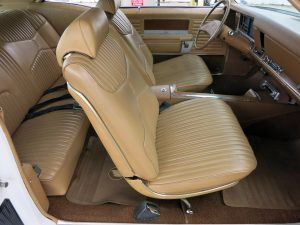
And it’s far from tight on the inside – the chief virtue of these small-on-the-outside crossovers.
The driver and front seat passenger enjoy 41.7 inches of legroom but the big stat is the 35 inches of backseat legroom. This is lots of room for a vehicle this small. It is almost exactly the same amount of room as inside that ’70 Riviera. It had a superabundance of cool – but less space than you’d think given how large it was on the outside.
The Encore has even more space behind its back seats – 17.8 cubic feet. This expands to 42.7 cubic feet when you lower the back seat. Which is almost three times as much room as the ’70 Riv had in its trunk, which was also low and wide but not tall – and so you couldn’t close it with tall things inside it.
While the exterior styling of this thing isn’t exactly Frank Sinatra, the inside look is more so. Echoes, again, of the calming fluidity and grace you used to find inside Buicks. A cut-above vibe and also relaxing by dint of not being over-the-top with technology. The gauges are analog, many of the major secondary controls are knob and button, none hard to reach or inscrutable. A small thing that’s a big thing in terms of everyday usefulness is the steering wheel-mounted thumbwheel for the radio volume. Other vehicles have this, too – but that doesn’t make it any less good that the Encore has it as well.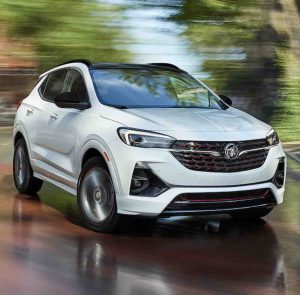
GM’s touchscreens are also better-than-average in terms of ease-of-use. A few large buttons rather than twice as many small ones. Plus, it’s not necessary to use them as much as most of them activate tertiary functions that you won’t need to access as often as things like the temperature control (controlled by a simple left-right knob) or the audio system (in addition to volume, you can change stations using another steering wheel-mounted thumbwheel).
Final pat on the head – for the forward-mounted and visible USB and 12v power points, just ahead of the gear selector. Here Buick is among the few that don’t hide the USB ports inside the center console storage area.
Many new cars – of all kinds – no longer include a 12V power point at all.
Buick charges significantly more for the Encore than rivals like Mazda charge for their equivalent offerings because Buick is a higher-zoot brand.
But do you get a higher-zoot vehicle?
Yes – and no.
The standard/optional equipment that comes in – or can be had – in the Buick is similar to what comes standard – and is available in – rivals like Mazda and Honda, for significantly less money.
If the Buick’s turbo’d engines gave it a significant mileage – or power – advantage over its bigger engined/lower-cost rivals, the price difference would make more sense.
To be fair to Buick, the Encore does offer the whole megillah of “advanced” driver saaaaaaaaaaaaaaaaaaaaaaaaaafety “assistance” technology, including automated emergency braking (for when you’re sleeping) and jerk-the-wheel steering (for when your car’s tire touches a painted line or you try to pass or turn off the road without signaling, which cancels the “assist”).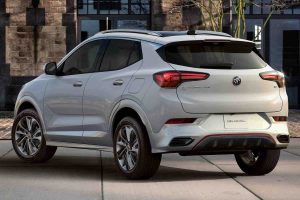
But if you don’t want these “assists” it’s a non issue – and you can spend the thousands you saved on things like a sunroof or a better stereo.
Or a bigger, stronger engine.
The Bottom Line
A smaller price would probably help sell this small crossover better.
. . .
Got a question about cars, Libertarian politics – or anything else? Click on the “ask Eric” link and send ’em in!
If you like what you’ve found here please consider supporting EPautos.
We depend on you to keep the wheels turning!
Our donate button is here.
If you prefer not to use PayPal, our mailing address is:
EPautos
721 Hummingbird Lane SE
Copper Hill, VA 24079
PS: Get an EPautos magnet or sticker or coaster in return for a $20 or more one-time donation or a $10 or more monthly recurring donation. (Please be sure to tell us you want a magnet or sticker or coaster – and also, provide an address, so we know where to mail the thing!)
If you’d like an ear tag – custom made! – just ask and it will be delivered.
My latest eBook is also available for your favorite price – free! Click here. If that fails, email me at EPeters952@yahoo.com and I will send you a copy directly!


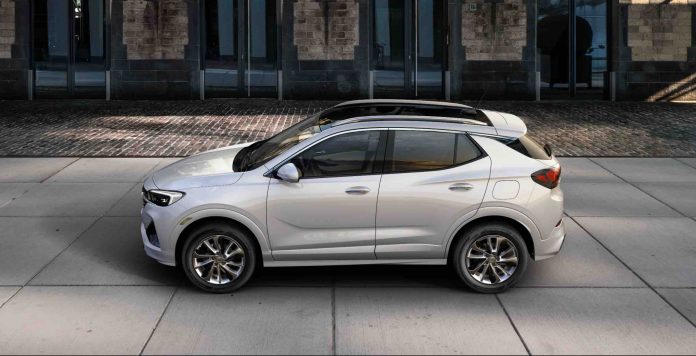

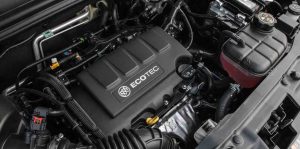


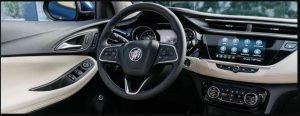
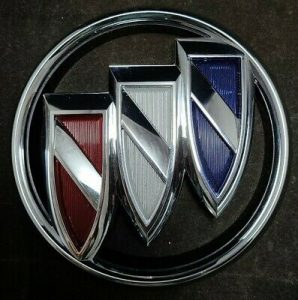








Nice article. I really appreciate for sharing such an informative post.
Thanks!
how did you get one of these to review?
did GM un-ban you?
Hi not you,
Don’t ask… because I better not tell!
heh, inquiry retracted!
😉
I drove a couple of recent GM products on my way to the Hyundai I eventually bought (which is still in the shop), a Spark and a Cruze. Both manuals. I was not impressed by either one. The Spark had excruciating throttle lag, the clutch and shifter were crimes against humanity both individually and in concert, and the short wheelbase + odd suspension tune made it feel like it wanted to snap around even in easy 4-6/10 cornering (which is an achievement, considering that my old Escort wagon had a similar wheelbase, wrecked springs and shocks, and a reputation for “interesting” suspension geometry and the only time it ever felt like that was when a rear tire was going flat.) The Cruze was an utter comminucation-free experience, with steering so lifeless that, during my impromptu roundabout test, I heard the tires squeal (barely, that car has an obscene amount of sound insulation) and never felt a single thing from the steering.
Pair that with the Road & Track article which highlighted a small but irritating tip-in lag even in track-oriented versions of the Camaro, and I’d say any modern GM car would have to be a hard pass from me.
As Yogi Berra said, It’s like Deja Vu, all over again. Extremely well written clear review of a vehicle which reminds me of the major changes in the auto industry circa late 70s to late 80s. Cars became less powerful, smaller and more expensive because of Government Edicts and theft, not because customers and the market demanded these things. Time to vote with your purse, force either the prices to drop or go elsewhere. The only GM product s worth buying are the trucks or truck based SUVs offered today. Or buy used, which is what I did. Good luck, we are all going to need it, cuz it will get worse before it gets better.
I don’t know why I looked at this review. My last Buick was a 1970 Riviera that got far better mileage than this one. Sure, it was a 455, but I had two dogs in the back seat with me barely outrunning a nasty cold front with a fifty mph tailwind from Wisconsin to north Mississippi to attend an all age field trial.
I was beat from work and stopped in southern Illinois to get a nap. The storm caught up and the wind rocked the car enough to awaken me. Staying abreast of the storm had no wind noise to mention at eighty on the road. The hook through NE Arkansas had slimy blowing snow and I was seemingly the last one that made it through before they closed the interstate. Trucks on both sides in the ditches, so they closed it for close to three days. My dogs would have been pissed if they had to spend two nights in a gymnasium/ traveler abode. We made it to Mississippi to a really bad motel and blowing snow. Of course my bitch ran away to hunt on her own for four hours.
It finally warmed up with a strong southerly wind to push us back north into the worst ice fog in central Illinois.
That 455 returned over thirty-six mpg on the trip. I even sent a note to Buick Division to give me a call if they wanted to have an owner talk up the economy car. They didn’t reply.
There was little wrong with the Escort wagon. Surely it was a toad, but very reliable and superb in the snow if you didn’t belly it out. That thing had the best heater in the business and was fun to flog it in the snow with the windows down.
I would buy another one if they were offered.
This doesn’t sound good. A late 90’s Park Avenue or Regal GS gets as good or better mileage with a nice pushrod iron 3.8 V6. And in a Park or a GS you’ll have no question you’re in a Buick.
BTW that 70 Riv is not my favorite. Dad’s 65, with its’ factory 425 dual quad cast iron header and posi unit is the first car I drove 120mph in. I was always disappointed by how hard it was to burn rubber with the 3.08 posi in a 4000 lb car, but the sound of those 8 barrels is not to be described. The Riv was intended to be a Grand Touring, not a dragster. Mileage, sadly, was less impressive. The factory manual says,” You can have good performance and good mileage, or great performance…” I’m going to have to pull her out of the barn and blow the dust off someday soon.
One of my favorite cars I owned was the Park Ave. Ultra. The blown engine was very good, and it came with the ‘touring suspension’ option which made it handle pretty good for a FWD car. It was a fabulous high speed cruiser in which the standard Park Ave. was not as much. I had three of them, before it got canned and I went to trucks.
Of course my current 300S V8 RWD blows away the Park Ave. in every category except rear seat room and trunk space.
I am not about to buy one of these even if I need a snow car. Chinky knows nothing about salt and road grime. To me the Saab was the only three that I had laughs from. Every cop would pull you over to issue a warning for polluting the air. Maybe it would have been less obnoxious if the two stroke was the used McDonalds fry oil.
I wonder how this car would do when the turbo pukes.
Speaking of blown engines, I am still awaiting my temporary plates for the Canadian CTS-V that is sitting in my driveway becoming sorely annoying to my wife.
Covid keeps the drones at DMV from doing anything to collect their tax wages. It all must be done through Hunter’s laptop to get any service.
One thing I recently learned because of the new EU extreme emission standards is you will be seeing less and less cylinders down the road. Why? Because it has gotten so ridiculous that engine designers can’t fix the problem of unburned fuel between the top ring and top of the piston. This minuscule amount is now an issue, and making engine manufacturers re-design everything. We pay, for nothing but decimal point on a piece of paper.
The bailout of GM was supposedly about saving jobs, jobs, jobs.
So where is this Buick manufactured – “The 2021 Encore GX will be assembled by: GM China (SAIC) at the Dong Yue plant in Yantai, Shandong, China. GM Korea at the GM Bupyeong plant in Bupyeong-gu, Incheon, South Korea.”
While Mary, what’s her name – GM’s diversity hire CEO, pulls in $21 million annually.
The companies that get in bed with chna are just cementing their demise.
I have seen it happen and it’s getting worse.
No thanks. Last time I had a car with a 1.2L engine, at least there were 4 cylinders, though only 50 hp. Not going back there! If I want an Anglia, or a Datsun B210, I will go find one.
What I want under the hood is the Slant Six and 727 Torqueflite of the modern day. 6 speeds would be OK, and 5 or 6 cylinders, 175 hp, and some bottom end grunt. That, and a B-Body-sized interior in a wagon. VW had something going with the 2.5L 5 cylinder, nice and reliable, not turboed, etc. But, they have been following the lemmings over the cliff of late with tiny turboed weenie engines, by and large.
I’ll take the Riv and would buy it today. Couldn’t pay me to drive that little Buick/Yugo wannabe, haha…
Hi Chris,
I would also rather have the Riv – and which Buick were making those of instead of these!
Saw a deal through costco around November last year on these for 40% off MSRP. Pretty good deal for someone in the market.
Ol’ Dave Buick, who founded the company in 1899, was an engine guy. He developed an overhead-valve engine, way ahead of its time, when flatheads were the only game in town.
He ended up selling his interest in Buick in 1906, when the auto revolution was just getting underway. Bad mistake: the later years were not kind, and he finished his life as a wage slave.
What would Dave Buick have thought of 1.2 and 1.3 liter three-cylinder engines gracing the Encore? Not much, probably.
Try recasting Bob Dylan’s “From a Buick 6” as “From a Buick 3.” It just don’t scan. 🙁
Every time someone says “Buick”, I think of Kojak’s baby turd brown Special cop car. What an ugly 70’s ride that was. Though, you are right, Buicks had OHV engines forever, when the rest of the US car companies (except Nash!) were building flatheads. And Charlie Nash built those OHV Nashes because he had worked for David Buick once upon a time.
I think Buick did indeed offer police package cars then…of course NYC detective cars probably got 3.8L V6s, not 455s.
But a baby turd brown 70s Buick Special/Century with a Stage 1 455 or even a turbo 6 out of a Grand National would be the ultimate sleeper!
Sure, there’s as much room as measured, but I’ll bet it feels much smaller than those land barges. The seats are going to be upscaled baby carriers that hold you in place until your legs cramp up. And nearly every surface of the vehicle has some sort of control or display. Those that don’t have claymores behind the facade. The cargo area is high, not wide, so those cubic inches better be tall, not flat.
I opened up a passenger side instrument panel recently, and the module therin read “THIS SIDE TOWARDS ENEMY”. Claymore indeed!